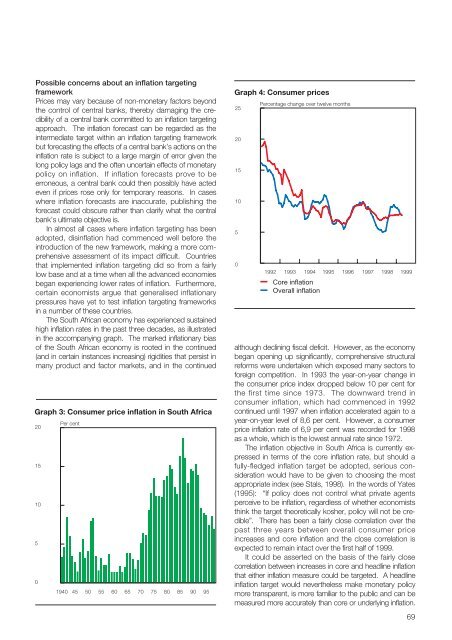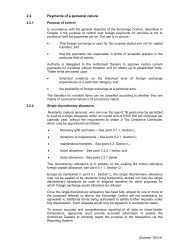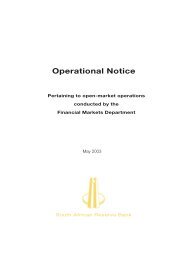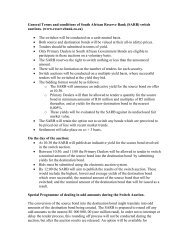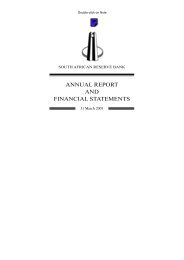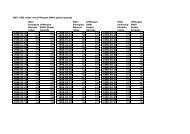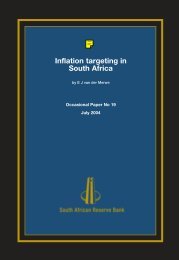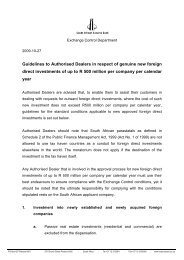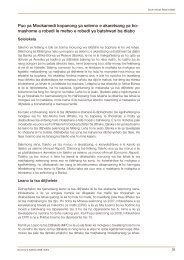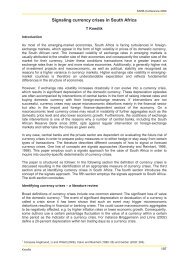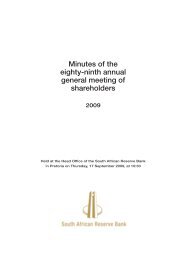Article: Quarterly Bulletin - South African Reserve Bank
Article: Quarterly Bulletin - South African Reserve Bank
Article: Quarterly Bulletin - South African Reserve Bank
You also want an ePaper? Increase the reach of your titles
YUMPU automatically turns print PDFs into web optimized ePapers that Google loves.
Possible concerns about an inflation targeting<br />
framework<br />
Prices may vary because of non-monetary factors beyond<br />
the control of central banks, thereby damaging the credibility<br />
of a central bank committed to an inflation targeting<br />
approach. The inflation forecast can be regarded as the<br />
intermediate target within an inflation targeting framework<br />
but forecasting the effects of a central bank’s actions on the<br />
inflation rate is subject to a large margin of error given the<br />
long policy lags and the often uncertain effects of monetary<br />
policy on inflation. If inflation forecasts prove to be<br />
erroneous, a central bank could then possibly have acted<br />
even if prices rose only for temporary reasons. In cases<br />
where inflation forecasts are inaccurate, publishing the<br />
forecast could obscure rather than clarify what the central<br />
bank’s ultimate objective is.<br />
In almost all cases where inflation targeting has been<br />
adopted, disinflation had commenced well before the<br />
introduction of the new framework, making a more comprehensive<br />
assessment of its impact difficult. Countries<br />
that implemented inflation targeting did so from a fairly<br />
low base and at a time when all the advanced economies<br />
began experiencing lower rates of inflation. Furthermore,<br />
certain economists argue that generalised inflationary<br />
pressures have yet to test inflation targeting frameworks<br />
in a number of these countries.<br />
The <strong>South</strong> <strong>African</strong> economy has experienced sustained<br />
high inflation rates in the past three decades, as illustrated<br />
in the accompanying graph. The marked inflationary bias<br />
of the <strong>South</strong> <strong>African</strong> economy is rooted in the continued<br />
(and in certain instances increasing) rigidities that persist in<br />
many product and factor markets, and in the continued<br />
Graph 3: Consumer price inflation in <strong>South</strong> Africa<br />
20<br />
15<br />
10<br />
5<br />
0<br />
Per cent<br />
1940<br />
45<br />
50<br />
55<br />
60<br />
65<br />
70<br />
75<br />
80<br />
85<br />
90<br />
95<br />
Graph 4: Consumer prices<br />
25<br />
20<br />
15<br />
10<br />
5<br />
0<br />
Percentage change over twelve months<br />
1992 1993 1994 1995 1996 1997 1998 1999<br />
Core inflation<br />
Overall inflation<br />
although declining fiscal deficit. However, as the economy<br />
began opening up significantly, comprehensive structural<br />
reforms were undertaken which exposed many sectors to<br />
foreign competition. In 1993 the year-on-year change in<br />
the consumer price index dropped below 10 per cent for<br />
the first time since 1973. The downward trend in<br />
consumer inflation, which had commenced in 1992<br />
continued until 1997 when inflation accelerated again to a<br />
year-on-year level of 8,6 per cent. However, a consumer<br />
price inflation rate of 6,9 per cent was recorded for 1998<br />
as a whole, which is the lowest annual rate since 1972.<br />
The inflation objective in <strong>South</strong> Africa is currently expressed<br />
in terms of the core inflation rate, but should a<br />
fully-fledged inflation target be adopted, serious consideration<br />
would have to be given to choosing the most<br />
appropriate index (see Stals, 1998). In the words of Yates<br />
(1995): “If policy does not control what private agents<br />
perceive to be inflation, regardless of whether economists<br />
think the target theoretically kosher, policy will not be credible”.<br />
There has been a fairly close correlation over the<br />
past three years between overall consumer price<br />
increases and core inflation and the close correlation is<br />
expected to remain intact over the first half of 1999.<br />
It could be asserted on the basis of the fairly close<br />
correlation between increases in core and headline inflation<br />
that either inflation measure could be targeted. A headline<br />
inflation target would nevertheless make monetary policy<br />
more transparent, is more familiar to the public and can be<br />
measured more accurately than core or underlying inflation.<br />
69


